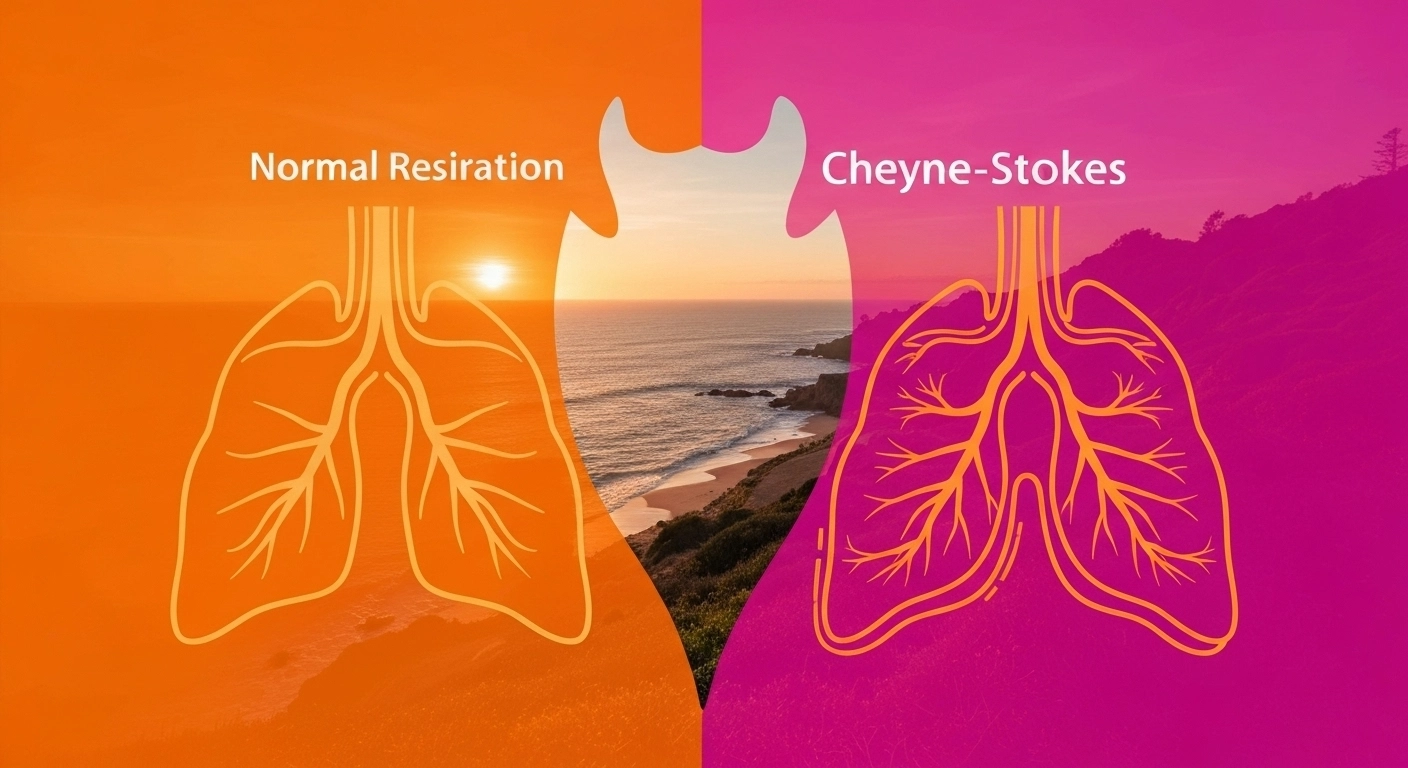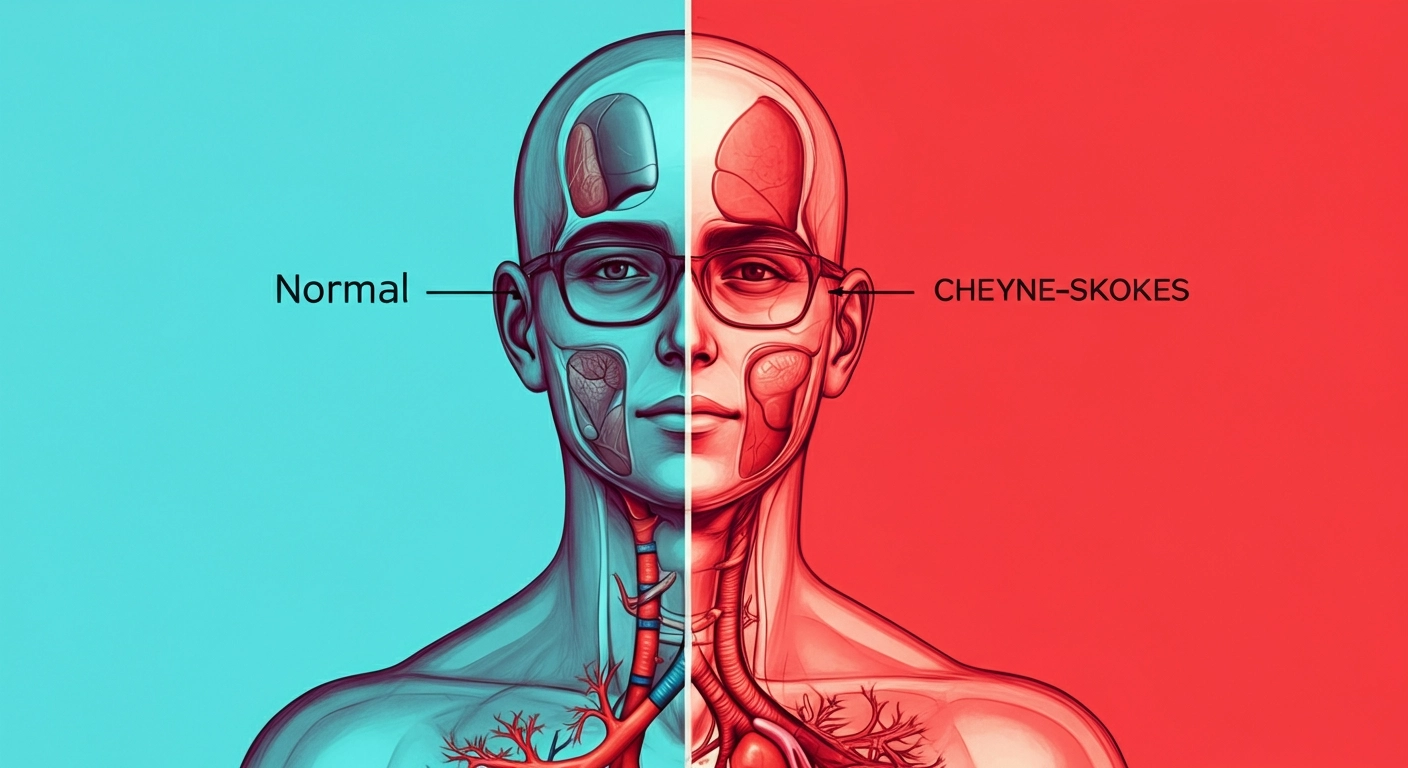Cheyne-Stokes respiration is a distinct pattern of breathing characterized by alternating periods of apnea and hyperventilation. This phenomenon often occurs during sleep, particularly in individuals with sleep apnea.
What is Cheyne-Stokes Respiration?

Cheyne-Stokes respiration is a distinct pattern of breathing characterized by alternating periods of deep, rapid breaths followed by gradual slowing and eventual cessation of breathing.
This cycle typically repeats every 30 seconds to 2 minutes. It is often associated with various medical conditions, including heart failure, stroke, and brain injuries.
How It Differs from Other Abnormal Breathing
Unlike other forms of abnormal breathing, such as rapid, shallow breathing seen in hyperventilation or irregular breathing patterns associated with panic attacks,
Cheyne-Stokes typically manifests in a rhythmic cycle. This pattern is commonly observed in patients with heart failure or neurological disorders, making it a critical indicator for medical professionals.
What causes Cheyne-Stokes breathing?
Recognizing the causes and risk factors of Cheyne-Stokes Respiration is essential for effective diagnosis and management in affected individuals.
Neurological Conditions
Understanding the interplay between neurological conditions and the development of Cheyne-Stokes respiration is crucial for adequate patient management and intervention strategies to improve respiratory function and overall quality of life.
- Brain Injuries: Brain injuries, particularly those that result in trauma to the central nervous system, can significantly disrupt normal respiratory patterns. Such injuries may lead to damage in areas of the brain responsible for autonomic functions, including the regulation of breathing. When the brain's ability to process signals related to oxygen and carbon dioxide levels is impaired, it can manifest as Cheyne-Stokes respiration. This condition is often seen in patients recovering from severe head trauma or those who have sustained a concussion with subsequent neurological complications.
- Brainstem Disorders: The brainstem plays a pivotal role in controlling involuntary functions such as breathing and heart rate. Conditions that affect the brainstem, including tumors or demyelinating diseases, can disrupt the normal respiratory drive. Disorders such as multiple sclerosis or amyotrophic lateral sclerosis (ALS) often lead to difficulties in maintaining consistent respiratory patterns, making individuals more susceptible to CSR. The dysregulation caused by these conditions can result in periodic changes in breathing depth and frequency, which are characteristic of Cheyne-Stokes respiration.
- Neurodegenerative Diseases: Neurodegenerative diseases further contribute to the development of Cheyne-Stokes respiration. As these diseases progress, they often affect various systems within the body, including those regulating respiratory function. For example, Parkinson's disease and Alzheimer's disease can lead to alterations in the central nervous system that impair normal breathing patterns. Patients with these conditions may experience fluctuations in their respiratory rate and rhythm due to neural degeneration, increasing their likelihood of developing CSR.
- Stroke: Stroke is another significant risk factor associated with Cheyne-Stokes respiration. A stroke can cause damage to specific regions of the brain that are essential for normal respiratory control. In particular, strokes affecting the brainstem or other areas implicated in breathing regulation can lead to disruptions that manifest as CSR. The severity and location of the stroke play a vital role in determining the extent of respiratory dysfunction experienced by the patient. Individuals who suffer from strokes are often monitored closely for signs of Cheyne-Stokes respiration as part of their rehabilitation process.
Cardiovascular Diseases
The relationship between CSR and cardiovascular diseases can’t be overstated, as it enables healthcare professionals to implement appropriate interventions to improve patient outcomes.
- Congestive Heart Failure (CHF): CHF, a condition where the heart’s ability to pump blood is compromised, results in inadequate perfusion of the brain and other tissues. The resultant hypoxia can trigger the brain's respiratory centers, leading to the characteristic oscillations in breathing.
- Atrial Fibrillation: Atrial Fibrillation, an irregular heartbeat that can lead to ineffective blood flow, may also contribute to the development of CSR by exacerbating fluctuations in oxygen levels, further influencing respiratory patterns.
Sleep Disorders
Understanding the sleep disorders risk factors associated with CSR is crucial for identifying individuals who may be predisposed to this condition.
- Central Sleep Apnea (CSA): Central Sleep Apnea occurs when the brain fails to send appropriate signals to the muscles responsible for controlling breathing. This pattern can lead to episodes of apnea followed by periods of rapid breathing as the body attempts to restore normal oxygen levels.
- Obstructive Sleep Apnea (OSA): In cases of Obstructive Sleep Apnea, physical blockages in the airway during sleep result in disrupted breathing patterns that may mimic or exacerbate CSR. The intermittent lack of airflow leads to repeated awakenings and subsequent hyperventilation episodes as the body responds to the drop in oxygen levels.
Symptoms and Signs of Cheyne-Stokes Respiration
Cheyne-Stokes Respiration signs and symptoms might vary from one person to another. Recognizing these symptoms and signs is crucial for timely medical intervention.
During Sleep
Cheyne-Stokes Respiration patients might exhibit symptoms during sleep, including irregular breathing patterns with periods of apnea, and noticeable fluctuations in breathing rate and depth.
- Irregular Breathing Patterns with Periods of Apnea: One of the primary symptoms is frequent awakenings during sleep, which can be attributed to the intermittent episodes of apnea. These disturbances can significantly impair sleep quality, leading to excessive daytime sleepiness and fatigue. The cyclical nature of Cheyne-Stokes respiration can create a sense of uncertainty for those affected, as they may experience moments of breathlessness followed by periods of normal breathing. This unpredictability can be distressing and may contribute to anxiety or apprehension surrounding sleep.
- Noticeable Fluctuations in Breathing Rate and Depth: The frequent interruptions in breathing can deprive the body of sufficient oxygen, leading to hypoxemia—an abnormally low level of oxygen in the blood. This condition not only exacerbates existing medical issues but also places additional strain on the cardiovascular system. Individuals with heart failure are particularly susceptible to these fluctuations, as their ability to adequately maintain oxygen levels is compromised. Consequently, managing these symptoms becomes crucial to enhancing the quality of life for those affected.
Daytime Symptoms
Individuals who suffer from Cheyne-Stokes Respiration don’t only struggle during sleep, but they also exhibit symptoms such as excessive daytime sleepiness, fatigue, and poor concentration during the day, among other symptoms.
- Excessive Daytime Sleepiness: Excessive daytime sleepiness is a prevalent symptom linked to Cheyne-Stokes respiration. Individuals may find themselves struggling to stay awake during the day, regardless of how much sleep they receive at night. This excessive sleepiness can significantly impair daily functioning, making it difficult to engage in routine activities or maintain productivity at work or school. The interrupted sleep patterns associated with CSR can lead to a fragmented sleep cycle, resulting in non-restorative slumber that fails to rejuvenate the body and mind adequately.
- Fatigue or Poor Concentration: Fatigue and poor concentration are additional symptoms that frequently accompany Cheyne-Stokes respiration. The cyclical nature of CSR can create an ongoing sense of exhaustion, as the body struggles to achieve restful sleep. This chronic fatigue can lead to cognitive difficulties, including impaired memory, decreased attention span, and diminished problem-solving abilities. As individuals grapple with these challenges, their ability to perform daily tasks may be compromised, leading to frustration and decreased quality of life.
- Shortness of Breath or Difficulty Breathing When Awake: Patients may experience a sensation of breathlessness that can vary in intensity and duration. This symptom may occur during physical activity or at rest and can significantly impact an individual's overall well-being. The underlying mechanisms contributing to this sensation may include compromised lung function or cardiovascular abnormalities that disrupt normal respiratory patterns. Addressing these symptoms is vital for improving patients' quality of life and managing the potential complications associated with CSR.
In Severe Cases
Severe cases of Cheyne-Stokes Respiration might suffer from symptoms such as Cyanosis and Restlessness, and Confusion During Episodes of Apnea, which highlights the importance of early detection and diagnosis.
- Cyanosis: One of the notable symptoms associated with this respiratory pattern is cyanosis, which manifests as a bluish discoloration of the skin, particularly around the lips and extremities. This occurs due to insufficient oxygen levels in the blood during the apneic phases, leading to hypoxemia. Healthcare professionals must recognize cyanosis as a significant indicator of underlying respiratory distress, especially in patients exhibiting Cheyne-Stokes respiration.
- Restlessness and Confusion During Episodes of Apnea: During these periods, the brain experiences a lack of oxygen, which can lead to altered mental status and agitation. Patients may exhibit signs of anxiety or discomfort, prompting them to move frequently or appear restless. This behavior reflects an innate response to the body's struggle for adequate oxygenation. Moreover, confusion can arise as cerebral hypoxia affects cognitive function, leading to difficulties in concentration or disorientation.
Impacts on Sleep and Health

Cheyne-Stokes respiration presents significant challenges to sleep quality and overall health. The cyclical nature of this breathing pattern leads to disrupted sleep architecture, increased risks for cardiovascular complications, and potential mental health issues.
As healthcare professionals continue to advance their understanding of CSR’s impacts, early recognition and appropriate management strategies are paramount in improving patient care.
Interruption of Normal Sleep Architecture
Individuals experiencing CSR often undergo frequent awakenings due to episodes of apnea or shallow breathing, which can prevent them from reaching deeper stages of sleep, such as REM (rapid eye movement) sleep.
This disruption not only affects the quality of sleep but may also lead to excessive daytime sleepiness, impairing cognitive functions such as attention, memory, and decision-making.
Chronic sleep deprivation resulting from CSR can contribute to long-term health issues, including obesity, diabetes, cardiovascular diseases, and mental health disorders, thereby underscoring the importance of addressing this respiratory condition.
Higher Risk for Adverse Cardiovascular Events
Individuals with CSR are at a higher risk for adverse cardiovascular events due to the cyclic fluctuations in oxygen levels that accompany the respiratory pattern.
The intermittent hypoxia experienced during apneic episodes can lead to increased sympathetic nervous system activity and elevated blood pressure, which may exacerbate underlying heart conditions.
As a result, patients with CSR often face an increased likelihood of developing heart failure or experiencing arrhythmias. Healthcare providers must recognize and manage CSR effectively to mitigate these risks and improve patient outcomes.
Mental Health Decline
The frustration and anxiety associated with disrupted sleep and the fear of choking or suffocation during apneic episodes can contribute to a heightened state of stress.
Patients may experience mood disturbances such as depression or anxiety disorders as a result of their compromised sleep quality and health concerns. This interplay between CSR and mental health highlights the need for a holistic approach in treating affected individuals, addressing both respiratory issues and their psychological consequences.
Treatment and Management Options
Effective treatment and management options are essential to alleviate symptoms and improve the quality of life for affected individuals. A multidisciplinary team approach is often beneficial in tailoring interventions to meet the unique needs of each patient.
Addressing Underlying Causes
One of the primary steps in treating Cheyne-Stokes respiration involves addressing any underlying medical conditions contributing to the abnormal breathing patterns.
For instance, in cases where heart failure is the root cause, optimizing heart function through medication management, lifestyle changes, and potentially surgical interventions may be necessary.
Additionally, identifying and managing other coexisting conditions, such as sleep apnea or chronic obstructive pulmonary disease (COPD), can also lead to improvements in CSR symptoms. By targeting these foundational issues, healthcare providers can significantly reduce the frequency and severity of Cheyne-Stokes respiration episodes.
Medications
Medications play a vital role in the management of CSR, particularly when related to heart failure. Diuretics may be prescribed to alleviate fluid overload, thereby improving cardiac output and subsequently reducing CSR symptoms.
In some cases, the use of positive inotropic agents or angiotensin-converting enzyme (ACE) inhibitors may be warranted to enhance myocardial contractility and overall cardiac function. However, it is essential to tailor medication regimens to the individual patient’s needs and monitor for potential side effects.
Positive Airway Pressure (PAP) Therapy
Positive Airway Pressure (PAP) therapy is another effective treatment option for patients suffering from Cheyne-Stokes respiration, especially those with concurrent obstructive sleep apnea.
Continuous Positive Airway Pressure (CPAP) or Bi-level Positive Airway Pressure (BiPAP) can help maintain airway patency during sleep, thereby reducing the frequency of apneic episodes and improving overall oxygenation levels. The use of PAP therapy has shown promising results in decreasing the severity of CSR and enhancing sleep quality for affected individuals.
Adaptive Servo-Ventilation (ASV)
Adaptive Servo-Ventilation (ASV) is an advanced form of ventilatory support that is particularly beneficial for patients experiencing Cheyne-Stokes respiration.
ASV continuously monitors the patient’s breathing patterns and automatically adjusts pressure delivery to stabilize ventilation during both hypopneas and apneic events.
This personalized approach helps mitigate fluctuations in respiratory effort, ultimately leading to improved gas exchange and reduced symptoms of CSR.
Oxygen Therapy
Oxygen therapy is also a critical component in the comprehensive management of Cheyne-Stokes respiration, particularly in patients with hypoxemia.
Administering supplemental oxygen can help ensure adequate oxygenation during periods of apnea or hypopnea, thus preventing complications associated with low oxygen levels.
Healthcare providers must assess each patient’s oxygen needs carefully and adjust therapy based on ongoing monitoring and evaluation.
Lifestyle Modification
The treatment and management options for Cheyne-Stokes respiration emphasize the importance of lifestyle modifications such as weight management, enhanced sleep hygiene, and the avoidance of sedative medications.
These strategies not only help improve respiratory function but also contribute to overall well-being.
- Weight Management: Weight management is a significant factor in the treatment of Cheyne-Stokes respiration. Obesity can exacerbate respiratory issues by increasing the load on the respiratory system and impairing lung function. Therefore, achieving and maintaining a healthy weight is essential for individuals experiencing CSR. A balanced diet combined with regular physical activity can help reduce excess weight while also improving cardiovascular health. Engaging in moderate exercise not only aids in weight loss but also enhances lung capacity and overall endurance.
- Sleep Hygiene: Sleep hygiene is another critical aspect of managing Cheyne-Stokes respiration. Poor sleep quality can aggravate respiratory problems and lead to increased episodes of apnea. Individuals are encouraged to establish a consistent sleep schedule, create a comfortable sleep environment, and engage in relaxation techniques before bedtime. Additionally, elevating the head while sleeping can facilitate better airflow and reduce the likelihood of respiratory disturbances during the night.
- Avoidance of Sedative Medications: Sedatives can depress the central nervous system, resulting in further respiratory depression and exacerbating existing breathing irregularities. Healthcare providers should carefully evaluate the medications prescribed to patients with CSR, opting for non-sedative alternatives when possible. Patients must communicate openly with their healthcare professionals regarding any medications they are taking and their potential impact on their respiratory condition.
FAQs
Is Cheyne-Stokes respiration the same as sleep apnea?
Cheyne-Stokes respiration is characterized by a cyclical pattern of breathing that alternates between periods of deep breaths and periods of apnea, often associated with heart failure or brain injury. In contrast, sleep apnea is a disorder marked by repeated interruptions in breathing during sleep.
How can I tell if someone has Cheyne-Stokes respirations?
Watch for signs of distress or changes in skin color, as these may accompany the irregular breathing pattern. Monitoring pulse oximetry can provide further insight into oxygen saturation levels during episodes of Cheyne-Stokes respirations.
How is Cheyne-Stokes respiration diagnosed?
Advanced diagnostic tools, such as polysomnography or continuous monitoring in a sleep lab, may also be employed to confirm the presence of Cheyne-Stokes respiration.
Can Cheyne-Stokes breathing be fatal?
While not inherently fatal, these respirations are often associated with severe medical conditions such as heart failure, stroke, or advanced neurological disorders.
Conclusion
Cheyne-Stokes respirations are often associated with various medical conditions, particularly in patients with heart failure, stroke, or terminal illnesses.
Understanding Cheyne-Stokes breathing is crucial for healthcare professionals, as it can serve as a significant clinical indicator of underlying health issues.
Monitoring this respiratory pattern allows for timely interventions and better patient management. Ultimately, recognizing and addressing the implications of the Cheyne-Stokes breathing pattern can enhance patient care and improve the quality of life in affected individuals.
Jessica H.
Jessica is a reviewer, writer, and sleep enthusiast at Sleepiverse. Jessica graduated with her master's degree in Nursing research and education. She is a registered nurse and currently works in the Intensive Care Unit. Since becoming a nurse, Jessica has worked the night shift, which means a disrupted sleep schedule. Knowing she needed to function at her best while caring for patients at night, she spent a lot of time researching how to sleep well with a difficult schedule.


